In which we spend a week in what has to be the best looking subcompact car ever to grace the streets of America
Pros:
Exterior styling
Upscale interior finish
Entertaining chassis
Cons:
Zoomy center stack
A little low on power

Kinetic design
Much of what we like about the new Ford Fiesta has to do with both its exterior and interior styling. As part of the company's "One Ford" plan Ford of Europe, with its years of expertise in small cars, is responsible for both the engineering and styling of the Fiesta.
Styling responsibilities, therefore, were placed with Martin Smith, Ford of Europe's Executive Director of Design. Both an engineer as well as a designer, he describes the company's design philosophy this way, "Outstanding design is what sets our brand apart and what excites our customers. With the development of Ford kinetic design in 2005, we introduced a new design language which has given our models a distinctive and, above all, dynamic look. The building blocks of kinetic design – defining the stance and how the body is set over the wheels; strong and precisely executed surfacing; the dynamic, expressive lines and creating a sleeker aerodynamic profile – are all very much in line with what we believe customers want."
The result is one of the best-looking vehicles in this class currently gracing American roads.
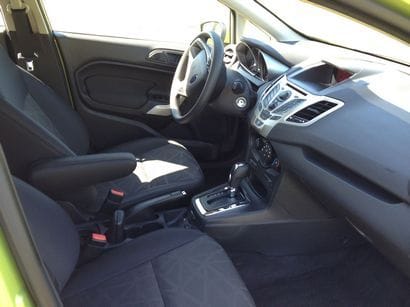
Interior
Inside, there is plenty of leg and head room for adults of just about all sizes up in front. The seats are nicely bolstered and covered in what appears to be a very sturdy fabric. Inserts in the cushions and back feature a tasteful muted monochrome geometric pattern. The driver's seat is equipped with an arm rest as well as a height adjustment feature that even allows those of us who are vertically challenged to compensate for the Fiesta's somewhat high beltline.
The rest of the interior is also first-rate. Soft-touch surfaces with a quality feel are found throughout the cabin and include those dash surfaces closest to the driver and passengers as well as the all-important door arm rest area that is also surrounded by soft fabric.
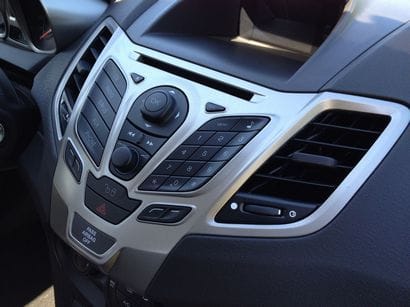
The steering wheel, although not wrapped in leather, has a substantial feel to it with just the right amount of grip. It also tilts and telescopes, making it easy to find a comfortable driving position.
I also have to admit that I've pretty much gotten over my initial objections to the "Klingon-esque" center stack. Once you get used to it, it's really not that bad. Besides, what it really has going for it is that, like the rest of the interior, the fit and finish of it are every bit as good as any Volkswagen or, dare we even say it, Audi.
Cargo room is a generous (for this sized vehicle) 15.4 cubic feet. The rear seat backs have a 60-40 split and can easily be flipped forward from either of the side doors or from the rear hatch area.
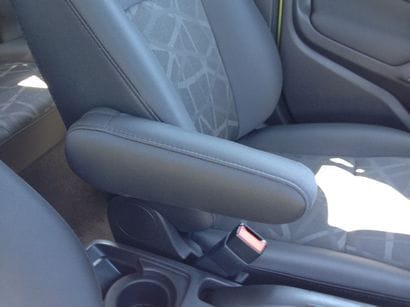
A particularly nice touch is the ability to flip the two outboard rear headrests forward to a horizontal position, dramatically improving the still somewhat limited visibility out the rear hatch window.
But while the standard rear doors make ingress and egress easy, adults sitting in back will find that, typical for this segment, legroom is a little tight at 31.2 inches.
One other minor nit that I have is the fact that the rear seat cushion doesn't fold forward. This means that when the seat backs are flipped down the rear cargo area doesn't feature a flat floor front to back.

Equipment
Our Lime Squeeze metallic Fiesta SE hatchback came very well equipped, even without the extras. Power windows, mirrors (with blind spot "spotters") and door locks with keyless entry were all standard. Tilt and telescoping steering wheel, variable wipers, rear spoiler and window defroster and an AM/FM/CD/MP3 player with auxiliary input jack were also part and parcel of the Fiesta.
Finally, stability control and a full complement of airbags including driver/passenger, driver knee, side and side curtain airbags are also standard.

Options included the 203A equipment group that adds SYNC, cruise, a very cool pair of LED parking lamps, an 80-watt sound system and painted alloy wheels ($1,245 less a $550 discount). The dual clutch Power Shift 6-speed automatic tacked on an additional $1,245, while a "Winter Package" consisting of heated front seat cushions and outside mirrors tallied another $220.
Base price was $15,670 and, with destination, the total MSRP bottom-lined at $18,475 including a $795 destination charge.
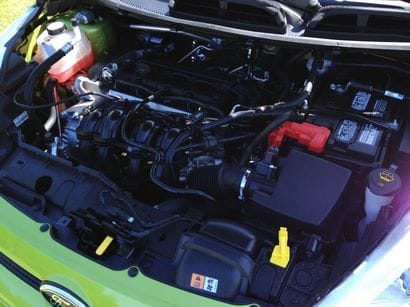
On the road
We already had the chance to drive a six-speed manually-equipped Fiesta last year, so the main reason we wanted to get our hands on another one was the chance to drive one equipped with Ford's dual clutch automatic.
These DCT units are different because if you were to look inside the transmission case, you wouldn't find the torque converter and wet clutches of an ordinary hydraulic transmission. Instead, the Power Shift consists of two manual transmissions. One carries the odd gears, 1, 3, and 5 while the other carries the even gears, 2, 4 and 6 plus reverse. Both are inside the same case and work in parallel. Each transmission unit has its own independent computer-controlled clutch plus electromechanical actuators that shift the gears.
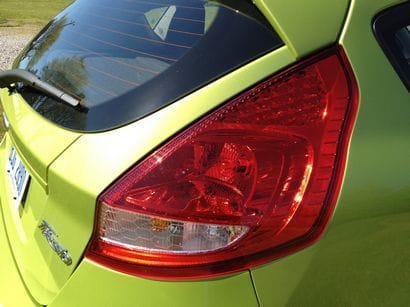
A dual clutch transmission is considered to be an automatic because the gear changes are controlled by a computer which directs the clutches to engage and disengage while delivering power to the wheels even during gear changes.
After a week of mostly around town cruising (and achieving an average of 34.2 mpg), I came away mostly impressed with Ford's latest engineering effort. I say mostly, because if you're used to a traditional automatic, the DCT will take some getting used to.
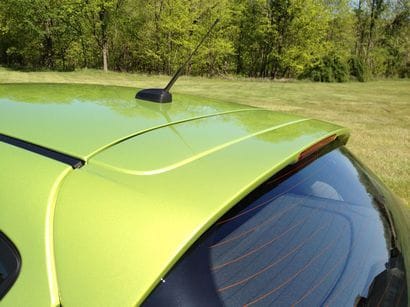
That's because under some circumstances, say on an incline of less than 5 degrees or less, taking your took my foot off the brake can result in rolling back slightly before the hill start assist feature kicks in. In addition, the shifts feel much more mechanical than those from a hydraulic transmission. Once you get used to it, however, I think you'll find it to be quite satisfactory.

On the road
All Fiestas (at least until the hotshoe ST version hits new car dealer showrooms later this year) are equipped with a 1.6-liter, 119-horsepower TiVCT Duratech DOHC inline-4.
If you adhere to the axiom that it's a whole lot more fun to drive a slow fast than a fast car slow, then it's easy to fall for the Fiesta, despite the fact that its 10.1-second naught to sixty dash (as measured by Car and Driver, not us) might seem to be a bit of a disappointment.

Not only does the Fiesta maintain a straight line without a fuss, but it begs to be thrown into corners. Despite the fact that it's equipped with a fairly simple semi-independent setup in the rear, it's one of the best-handling vehicles in its class. Neither road imperfections nor washboard surfaces upset its demeanor. On top of that, highway noise is also minimal, thanks in part to judicious use of sound deadening materials including its SoundScreen windshield.

The Bottom Line
As we stated in an earlier review, if looks could kill, we'd be in the morgue right now. The Fiesta is the hands-down, drop-dead winner in the styling department. It's also a lot of fun to drive. Its straight line acceleration notwithstanding, the Fiesta's handling is solid and, even through the twisties, it will hold its own with any car in its class.
In our opinion, the Fiesta is certainly at the top of its segment. To quote Lee Iacocca, "If you can find a better car, buy it."














